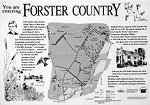The Times of 14.11.22 has a leading article on Literary Landscapes, supporting out view.

At the end of Howards End, E. M. Forster’s 1910 masterpiece, the author laments that his beloved Hertfordshire countryside, in which the novel is set, is being inevitably consumed by “the rust” of an ever-expanding London. So far, that has not happened, in large part due to the dogged work of tireless campaigners over many decades to prevent the land around his childhood home of Rooks Nest being turned over to developers.
Yet their dream of preserving “Forster country” for posterity is under threat once again, this time from plans by the local council to turn an area of meadow into a landscaped “country park” complete with a car park and toilet block. The plan has attracted opposition not only from local residents but also Historic England, the Oscar-winning actress Emma Thompson, who starred in the screen version of Howards End, and Professor Michael Proctor, the provost of King’s College, Cambridge, where many of Forster’s papers are kept.
Nor is Forster country by any means the only literary landscape that needs defending. A campaign is ongoing against plans to build 1,200 homes on Chawton Park Farm, near Jane Austen’s childhood home in Alton. Lord Fellowes of West Stafford, creator of Downton Abbey, was part of a successful campaign to prevent a housing estate being built next door to a manor that provided inspiration to Thomas Hardy for his novel The Mayor of Casterbridge. Meanwhile, some literary landscapes have already disappeared. The land that inspired Richard Adams’s Watership Down is now a housing estate outside Newbury.
Such developments should be considered acts of cultural vandalism. The Council for the Protection of Rural England has long proposed that landscapes of artistic interest should received special designation similar to those of scientific interest. It is a good idea whose time has come




